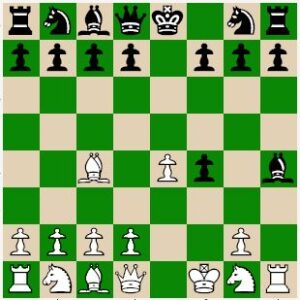
I’ve played 1. e4 e5 2. f4 exf4 3. h4 226 times. According to modern opening theory, 3. h4 is so bad that it doesn’t rate inclusion, but I’ve won 70 percent of 226 games (a hair better than the 67% win rate in other 1. e4 games).
At a glance, Black should do well against 3. h4 with natural moves like 3…Nf6 and 3…d5. I’m surprised that I’ve won 70% against 3…Nf6, and not surprised at 42% when they play 3…d5.
That’s what we should expect — for 3…d5 to put a silly move like 3. h4 out of business — but that’s not how average chessplayers think. Average chessplayers react to 3. h4 like Lyttelton did against Morphy, and play 3…Be7 to threaten the pawn.
66 opponents out of 226 played 3…Be7, and then after 4. Bc4, 58 of them continued 4…Bxh4+ (it’s not too late for 4…d5, which beats me more often than not) 5. Kf1.
Which brings us to the final exam question: If White could make another move here, what should White play?
White wishes to play 6. Qh5, threatening mate by 7. Qxf7 or capture by 7. Qxh4.
Each time I mentioned Scholar’s Mate in this series of blog entries, I told you ‘this will be on the exam’. So you saw 6. Qh5, right?
Here’s the shocker. 14 opponents enabled that fork. I think it’s howlingly funny, that in a world of chessplayers who think opening study is useful, 14 of 58 missed a fork where half the point is Scholar’s Mate. Two opponents played 5…Nf6, dropping the bishop to 6. Rxh4.
Here’s a follow-up question. Following 1. e4 e5 2. f4 exf4 3. h4 Be7 4. Bc4 Bxh4+ 5. Kf1, what should Black play?
One reason for 3. h4 is inhibiting …g7-g5, which temporarily shuts out the c1-bishop. After 5. Kf1, Black should play a move that preserves the h4-bishop, and strengthens the f4-pawn. Computers believe 5…Bg3 does the trick — in 15 of those, I’ve won 8, lost 6, drawn 1.
In other words, even with best play by Black in the Double Bishops’ Gambit Accepted — chasing the pawn with 3…Be7, then capturing by 4…Bxh4+ — White can reach a playable middlegame.
This is a link to a PGN file with 58 Double Bishops’ Gambits Accepted.